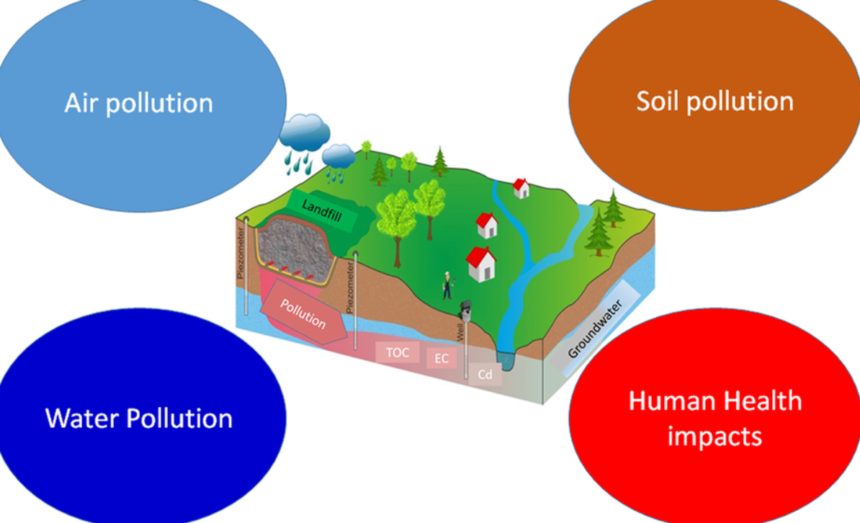Introduction: Technological transformation needs for landfill risk prevention and control
According to the Global Solid Waste Management Outlook, global landfill methane emissions account for 12% of anthropogenic emissions, equivalent to 320 million tons of carbon dioxide equivalent released each year. Landfills are not only an important source of global greenhouse gas emissions, but also an important challenge to ecological security. As a highly efficient greenhouse gas, methane has a greenhouse effect 25 times that of carbon dioxide, and is very prone to explosion within a specific concentration range, posing serious safety hazards to landfills and surrounding environments.
With the development of the Internet of Things (IoT), artificial intelligence (AI), remote sensing technology, and high-precision gas detection technology, the application of intelligent monitoring equipment in landfill management has gradually become a trend. This article will deeply analyze the multidimensional application of intelligent monitoring technology in landfill risk prevention and control from three key areas: gas explosion warning, soil settlement monitoring and modeling, and ecological pollution tracing and governance.
1. Intelligent Early Warning System For Gas Explosion Risks
①. Breakthrough in wide-area detection technology
Methane leakage and accumulation are one of the most common and dangerous hidden dangers in landfills. The new detection equipment uses tunable semiconductor laser absorption spectroscopy (TDLAS) technology, which can achieve long-distance and wide-coverage real-time methane monitoring. TDLAS technology uses high-precision spectral scanning to identify the characteristic absorption peaks of methane molecules, and then accurately measure the methane concentration.
Compared with traditional infrared detection or catalytic combustion sensors, TDLAS has higher sensitivity and anti-interference ability. In complex terrain and multi-gas interference environments, TDLAS can still maintain stable monitoring accuracy. According to the US Environmental Protection Agency (EPA) research, this technology can increase the landfill gas detection coverage from the traditional 75% to 98%. In terms of reducing the incidence of explosion accidents, the TDLAS system has been proven to reduce the accident rate by 65%.
②. Dynamic warning with millisecond response
Real-time response capability is the core competitiveness of the gas warning system. The detection response speed of the current new generation of monitoring equipment has reached 10 milliseconds. Combined with AI algorithms and big data modeling, it can predict the methane accumulation and explosion risk level inside the landfill 15-30 minutes in advance.
Experimental data from the EU Joint Research Center (JRC) show that the system has an accuracy of 0.01% in identifying methane concentration fluctuations, which is significantly better than traditional equipment (usually 0.05% to 0.1%). The gas diffusion model based on deep learning can automatically eliminate environmental noise, dynamically adjust the monitoring threshold, and maintain high sensitivity and early warning accuracy. JRC data shows that the early warning accuracy of the system is 47 percentage points higher than that of traditional equipment.
③. Intelligent linkage disposal system
The linkage between the early warning system and the automated disposal system is a key link in the intelligent management of landfills. When the monitoring system detects that the methane concentration exceeds the safety threshold, the system will automatically trigger the following disposal measures:
Ventilation system start-up: Through high-power exhaust equipment, the methane concentration in the enclosed space is quickly reduced.
Spray system activation: methane diffusion is suppressed through water mist to reduce the risk of static electricity accumulation.
Enclosed warning area: According to the direction of gas diffusion, an unmanned area is set up to ensure that safety personnel avoid danger.
2. Intelligent Monitoring And Modeling Of Soil Subsidence
①. Multi-source data fusion monitoring
Soil subsidence monitoring is an important part of landfill stability management. The InSAR satellite remote sensing technology currently used in landfills, combined with ground detection equipment, can achieve millimeter-level subsidence monitoring. InSAR technology obtains detailed information on surface deformation by analyzing satellite radar data in different time periods.
②. Three-dimensional geological modeling technology
Based on ground subsidence monitoring, the intelligent system can establish an accurate three-dimensional digital twin model based on GIS (geographic information system) and laser scanning data.
The application case of the Lille landfill in France shows that by simulating the underground subsidence trend, the model can predict the subsidence changes in the next 5 years, helping engineers optimize the design of the anti-seepage layer and supporting structure, and reducing the risk of cracking and leakage in the landfill by 42%.
3. Accurate Tracing And Governance Of Ecological Pollution
①. Centimeter-level positioning technology
Landfill pollution tracing requires high-precision leakage point positioning capabilities. Modern detection equipment uses high-precision GPS and Beidou satellite navigation systems, and the positioning accuracy can reach 0.1 meters.
According to data from the California Environmental Protection Agency, the technology reduces the time for locating landfill leakage points to less than 5 minutes, increases the efficiency of repair projects by about 300%, and reduces the cost of handling a single accident by up to $750,000.
② Pollution diffusion simulation system
Combined with meteorological data (such as wind speed and direction) and terrain features, the system can establish a real-time pollution diffusion simulation model to predict the pollution diffusion path within 48 hours.
The application of the Vancouver landfill in Canada shows that through this system, the dispatch center can complete resource deployment within 1 hour before the pollution spreads, minimizing the impact of pollution on the surrounding environment.
Conclusion: Intelligent Monitoring Drives Sustainable Development
The application of intelligent detection equipment is driving the transformation of landfill management from passive emergency response to active prevention and control. The U.S. Department of Energy estimates that after a landfill of one million cubic meters is optimized through an intelligent monitoring system, the annual power generation can increase by 12 million degrees, while reducing carbon dioxide emissions by 15,000 tons.
In the future, with the deep integration of the Internet of Things, AI and big data technologies, landfills will become important nodes in urban energy circulation and environmental governance, driving the world towards a greener and smarter waste management system.














